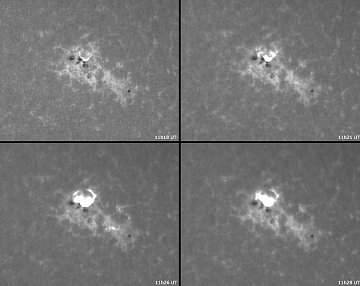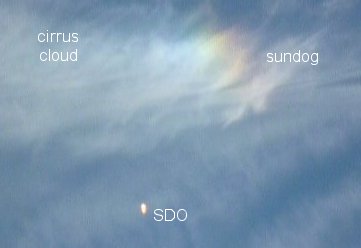SATELLITE FLYBYS APP: Turn your iPhone or iPod into a field-tested satellite tracker! Spaceweather.com presents the Satellite Flybys app. | | | TGFS AND AIR TRAVEL: Terrestrial gamma-ray flashes (TGFs) course through thunderstorms at about the same altitude where commercial airliners fly. Do these blasts of gamma-radiation pose a hazard to air travelers? Researchers discuss the possibilities in today's story from Science@NASA. SOLAR FLARE: Sunspot 1046 is crackling with M-class solar flares. This morning in the Netherlands, amateur astronomer Emiel Veldhuis happened to be looking when one of them erupted. He captured the following images using a Lunt LS60T CaK backyard solar telescope: 
Click to view an animation
The brief but powerful flare registered M8.3 on the "Richter scale" of solar flares. NASA's STEREO-B spacecraft also recorded a movie of the event, which was the strongest flare in more than two years. More eruptions are in the offing; readers with solar telescopes should train their optics on sunspot 1046. more images: from Terje Isberg of Biberstein, Switzerland; from Dennis Simmons of Brisbane, QLD, Australia; from Peter Paice of Belfast, Northern Ireland; from James Kevin Ty of Manila, the Philippines; from D. Booth and J. Stetson of South Portland, Maine; from Etienne Lecoq of Mesnil Panneville, Normandy, France SDO DESTROYS A SUNDOG: The Solar Dynamics Observatory (SDO) lifted off from Kennedy Space Center on Thursday morning, Feb. 11th, kicking off a 5-year mission to study the variability of the sun. Moments after liftoff, SDO did something that astonished and delighted observers. It flew right through a bright, rainbow-colored sundog and destroyed it. Click on the image to launch a 10 MB Quicktime video recorded by13-year-old Anna Herbst of Bishop, California: 
Sundogs are formed by plate-shaped ice crystals floating in cirrus clouds. "When SDO's Atlas V rocket penetrated the cirrus, shock waves went rippling through the cloud and destroyed the alignment of the crystals," says atmospheric optics expert Les Cowley. "This extinguished the sundog." Play the movie again and this time turn up the volume to hear the reaction of the crowd when the waves hit the sundog. "I've never seen anything like it," said Anna's friend and traveling companion Amelia Phillips. "It was amazing!" This was an auspicious beginning indeed for a mission designed amaze. Once it reaches its final orbit, SDO will make IMAX-quality movies of solar explosions and peer beneath the stellar surface to see the sun's inner magnetic dynamo. No one has ever seen anything like that either. Stay tuned for updates.
February Northern Lights Gallery
[previous Februarys: 2009, 2008, 2007, 2006, 2004, 2003, 2002] | 
